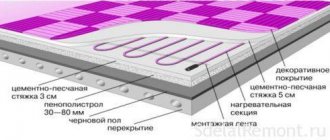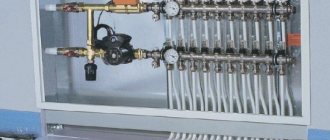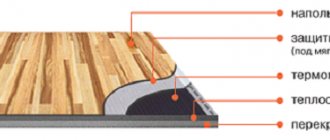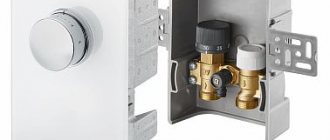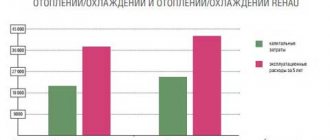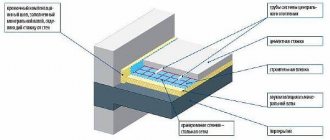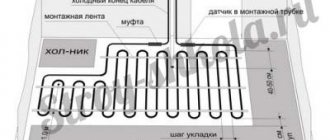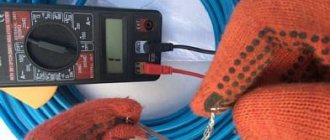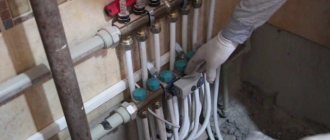Comfort in the home begins with warmth. To ensure optimal temperature conditions, it is necessary to think about not only the decoration of the walls, but also take care of the warmth of the floor. For this purpose, you can choose a modern solution in the form of a heated floor laid under the tiles.
Warm floor Devi brand
One of the leading brands is Devi. A devi heated floor involves a whole set of different components: cables and mats, thermostats and mounting elements. All products are manufactured to high international standards.
The main advantages of Devi heated floors
The advantages of heated floors from Devi include:
Calculation of installation of heated floor Devi
- saving energy through the use of thermostats;
- convenient placement of the system without wasting useful space;
- uniform heating of the air in the room;
- the ability to organize heating not of the entire room, but of a separate area;
The process of laying heated floors Devi - the ability to independently select the heating time (independent of the central system);
- ease of installation;
- Possibility of installation under any type of coating.
Warm floor. Instructions and Guides
This section contains manuals, instructions from underfloor heating manufacturers and other useful materials.
Information materials
- DEVI product catalog “Cable electric heating systems” (pdf, 1.8 Mb)
- Manual “Cable electric heating systems” (pdf, 4.3 Mb)
Instructions for installing thermostats
| Devireg 130 (pdf, 418 Kb) | Devireg 530 (pdf, 984 Kb) | Devireg 535 (pdf, 834 Kb) |
| Devireg 550 (pdf, 864 Kb) | Devilink (pdf, 2.5 Mb) | Devireg 316 (pdf, 224 Kb) |
| Devireg 330 (pdf, 523 Kb) | Devireg 610 (pdf, 192 Kb) | Devireg 850 (pdf, 1.2 Mb) |
Certificates for heating cables
| Deviflex DTIP-10 (pdf, 462 Kb) | Deviflex DTIP-18 (pdf, 963 Kb) | Deviflex DSIG-20 (pdf, 987 Kb) |
| Deviflex DSOT (pdf, 531 Kb) | Deviflex DTCE (pdf, 251 Kb) | Deviflex DPH-10 (pdf, 1 Mb) |
| Deviflex DTIV-9 (pdf, 350 Kb) |
Certificates for heating mats
- Devimat DSVF-150 (pdf, 556 Kb)
- Devimat DTIF-150 (pdf, 496 Kb
Certificates for heating cables and mats
- Certificate of compliance of Deviflex and Devimat with regulatory documents
- Fire safety certificate for cables DTIP, DSIG, DSIA, DTCE, DTIE-10
- Fire safety certificate for cables DSIZ,DSIX,DSM3
- Fire safety certificate for self-regulating cables iceguard, pipeguard
- Fire safety certificate for self-regulating cable DPH-10
- Sanitary and epidemiological certificate for deviflex heating cables and mounting brackets
Certificates for other products
- Certificate of conformity of Devirail heated towel rails with regulatory documents
- Certificate of compliance of steel and copper mounting tape devifast with regulatory documents
- Sanitary and epidemiological report on Devirail heated towel rails
- Sanitary and epidemiological certificate for Devicell mounting plates
- Sanitary and epidemiological report on Devifast mounting tape
- Sanitary and epidemiological certificate for the DEVI coupling for installing a heating cable in a pipe
Installation of heated floors. If you decide to install Devi floors, keep in mind that this is a highly reliable heating system that can be used both as the main heating system and for simple floor heating.
- Read more about installing heated floors.
- Photos of laying heated floors in this section of the site
Installation of infrared film floors . Anyone can install an infrared film floor. If you are not an expert in installing and connecting film, follow the further instructions. You can easily install infrared film flooring under laminate, linoleum or parquet boards and carpet.
- Read more about installing film heated floors
- Movie about styling
Warm floors in thin floors. Installation in a layer of tile adhesive. Floor heating can be carried out without any kind of extra expenses, destruction of floors, any dust and dirt. This is done as follows - thin DEVI heating mats are placed in a light layer of tile adhesive. Devimat mats are characterized by their low thickness - from 2.3 to four millimeters, depending on its type.
- Read more about installing heating mats in a layer of tile adhesive
- Photos of Devimat styling in this section of the site
Warm floors in concrete floors. Installation in cement screed . An ideal option in cases where you are planning to install a heating system in a building that has not yet been fully completed, where there is no screed yet - Deviflex heating cable. Its installation is carried out in a concrete or cement-sand screed, the thickness of which is from three to seven centimeters, due to which the floor warms up evenly, and its temperature remains comfortable at all times. Read more about installing a heating cable in a cement screed
Warm floors in wooden floors. DEVIDRY mats . Devidry heating mats are designed specifically for the so-called “dry” installation of heated floors under various coverings, such as laminate, carpet, linoleum, parquet, parquet boards less than 2.5 cm thick. Now the required temperature underfoot can be achieved easily and quickly, without any unnecessary work such as installing a heating cable in the screed. More about DEVIDRY mats
Ceramic tile
Ceramic tiles are the most suitable type. It is not only environmentally friendly, but also tolerates temperature changes well. However, such coatings lead to significant heating of the floor. If this is an ideal option for those who freeze when touching the tiles, then for a child’s room you cannot lay the floor, which will create an excess temperature of the coating. Children are active, so in too warm rooms they often become lethargic and get tired faster.
Laying tiles on warm floors
When choosing tiles, it is better to give preference to modern PVC. It not only has an attractive appearance, but is also warm enough without additional heating - this is important in the summer.
A natural stone
Instructions for laying heated floors under tiles
Stone tiles are also suitable for laying on warm floors. However, to glue it, you need to select special types of glue: epoxy or cement with modifying additives. Such mixtures are used for rubbing joints. They have elasticity, so they do not deform as a result of displacements caused by temperature transfers. The glue layer should be thin.
Alternatively, laminate can be used. It has a fairly dense structure that allows warm air currents to pass through. But there is one important point: the coating can only be laid on a completely dry floor. Otherwise, an under-dried floor will transfer moisture to the coating, which, after drying, will begin to deform and may crack.
Linoleum should not be laid on heated floors. High temperatures can cause the coating to deform and even change color.
Laying floor tiles on a warm floor
Installation of heated floor Devi
Installation of Devi underfloor heating depends on the type of heating elements - Deviflex heating cable, thin Devimat mat and Devidry underfloor heating under laminate.
Installation of Deviflex heating cable in a screed
Installation of the Devi heating cable begins at the construction stage: two plastic tubes are installed from each location for the installation box to the groove. Heat-insulating material 1-2 cm thick is laid on the base of the floor, cleared of foreign objects, for more economical heating of the room. It is also recommended to install waterproofing. Then a cement-sand screed is poured.
After this, the installation of the Devi electric heated floor continues with the installation of the heating cable:
- A mounting tape is laid every 50 cm of the floor, securing it with screws or nails. Thanks to the distance of 25 mm between its fastenings, installation of a Devi heated floor can be carried out on an area of any configuration, and also create differentiated heating power in local areas.
- Check the resistance of the heating cable, which should correspond to the value on the coupling sticker.
- Attach the heating cable to the mounting tape. The cable lines must not touch each other. The bending diameter of the heating cable must be 5 cm or more.
- A corrugated tube is installed between the heating cable lines, into which a floor temperature sensor will be placed. The safety tube is secured in the center of the cable loop to ensure proper operation of the sensor.
- A floor temperature sensor is installed in the tube.
Installation of Devi underfloor heating in the form of a heating cable ends here. The floor is filled with a cement-sand screed, making sure that there are no air pockets left. After it hardens, the decorative floor covering is installed.
Installation of thin mat Devimat under tiles
Installation of the thin Devimat mat under the tile must begin with drawing up a diagram that shows the installation area of the heating mat and the direction of its laying. It should be remembered that the heating mat is placed in areas not occupied by plumbing fixtures, cabinets, stoves and other stationary furniture.
Before starting work, lay a groove in the floor (if necessary, also groove the wall) and install a tube in which the floor temperature sensor will be installed. The end of the tube is closed with tape to prevent mastic or cement from getting into it. The other tube will carry the cable from the heating mat to the mounting box.
The floor is cleaned of dust and debris. A primer is applied to the base of the floor for better adhesion to the heating mat. Installation of the Devi electric heated floor is carried out in such a way that the floor temperature sensor is located between two lines of the heating cable applied to the mat.
If you need to place a heated floor next to plumbing fixtures, you can carefully cut the mat mesh and secure the heating cable, while keeping in mind the selected installation step. Remember that the heating cable cannot be cut.
After placing the mat on the floor, the connecting wires are laid to the installation box. Spread mastic or tile adhesive over the floor using a spatula. Make sure that no air bubbles form. After completing this work, the installation of the Devi heated floor can be considered complete. All you have to do is lay tiles or other covering on it.
Installation of heated floors under laminate
Installation of a Devi heated floor, intended in the case of Devidry for wood or laminate flooring , begins with drawing up a diagram of the room, which indicates the location of heating mats and filler mats, devoid of heating cables.
The surface on which the heated floor will be laid is cleaned of dust, debris and other elements. Devidry heating mats are installed and aligned along the connector line. If necessary, the unnecessary part of the mat is cut off. The connectors in the heating mats are connected using a special key and extension cords.
After this, filler mats are laid on the remaining floor surface. Using tape, you need to fasten the entire structure of the heating system. After this, connect the connecting wires to the thermostat, install the floor temperature sensor in the installation tube and mount it in a special groove.
The installation of the Devi heated floor is completed by making sure that the connectors are not damaged and are located evenly. The heating system is started to check its functionality: if at least one of the heating mats does not work, installation should be stopped.
If you are going to dismantle the Devi heated floor, keep the mat plugs. Make sure there is a cap on the last one before installing the final floor covering.
Cable underfloor heating in a country house - is it profitable?
Calculation of heated floors
Tile selection
When choosing tiles for a heated floor, you should pay attention to the following characteristics of the material, which are contained in the instructions:
- Hardness. For residential premises, hardness class 5-6 is sufficient.
Installation of heated floors under tiles - Degree of wear resistance. This indicator characterizes the resistance of the tile to abrasion and scratches. For rooms where people do not wear outer shoes (toilet, bathroom, balcony), the second class is sufficient, and for the hallway and kitchen a fourth or fifth class is required.
- Water absorption. For the bathroom it is better to choose tiles with a low index, and for the kitchen up to 6% is allowed.
- Chemical resistance. It is important for the bathroom and kitchen.
- Porosity of the material. For heated floors, it is necessary to select dense tiles.
Coverings such as bamboo parquet, carpet and classic wooden parquet cannot be used for heated floors.
Important points
To avoid problems during installation work, you should pay attention to the following important points:
- Carefully measure the length of the cable, since it will not be possible to shorten the heating cable.
- You can turn on the electric floor only after the screed and adhesive solution have completely dried. Until this point, it cannot be connected even for testing.
Informative table about Devi heating cables - The instructions state that before laying the cable, the floor surface must be cleared of blockages and primed.
- Do not walk on the cable while wearing high-heeled shoes.
- The sensor indicating the temperature should not be filled with screed or mortar. It is better to place it in a corrugated pipe.
- When carrying out installation, it is necessary to monitor the resistance indicators so that they are compared with those indicated in the instructions.
- Before installation, you need to draw a diagram taking into account the distances to the walls.
- To ensure that the cables do not fail, the floor surface must be completely insulated.
You can install a warm electric floor yourself. However, before carrying out work, the instructions must be carefully studied.
Test run of the Devi floor heating system
A test run of the Devi underfloor heating system involves briefly turning on the heated floor in heating mode (for a few minutes) from the thermostat. At the same time, power begins to be supplied to the heating cable, and the cable begins to heat up. You can feel the heating of the cable with your hand, as well as by signals on the thermostat (either a red light lights up or a heating symbol appears on the screen).
After a successful test of the heated floor, the regulator must be turned off, and you can begin the next construction work (pouring screed or gluing tiles).
More on the topic: article on quartzing premises for protection against viruses. part 2 about the role of hydrogen peroxide against infections. Gentle fasting on fermented teas. Human management: structural, unstructured and matrix. Hanging garden bed on the loggia of a multi-storey building
Installation manual for Devimat DSVF, DTIR, DTIF heating mats and Deviflex heating cables (9.1 MB, pdf).
